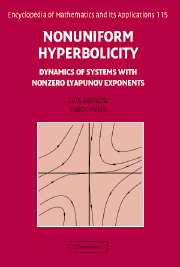Book contents
- Frontmatter
- Contents
- Preface
- Introduction
- Part I Linear Theory
- Part II Examples and Foundations of the Nonlinear Theory
- 6 Examples of Systems with Hyperbolic Behavior
- 7 Stable Manifold Theory
- 8 Basic Proper ties of Stable and Unstable Manifolds
- Part III Ergodic Theory of Smooth and SRB Measures
- Part IV General Hyperbolic Measures
- Bibliography
- Index
7 - Stable Manifold Theory
from Part II - Examples and Foundations of the Nonlinear Theory
Published online by Cambridge University Press: 05 May 2013
- Frontmatter
- Contents
- Preface
- Introduction
- Part I Linear Theory
- Part II Examples and Foundations of the Nonlinear Theory
- 6 Examples of Systems with Hyperbolic Behavior
- 7 Stable Manifold Theory
- 8 Basic Proper ties of Stable and Unstable Manifolds
- Part III Ergodic Theory of Smooth and SRB Measures
- Part IV General Hyperbolic Measures
- Bibliography
- Index
Summary
In this chapter we present one of the principal results of the nonuniform hyperbolicity theory – the existence of local stable and unstable manifolds. Roughly speaking, we show that if the differential of the system admits a hyperbolic behavior along a given trajectory then the system itself behaves hyperbolically in a sufficiently small neighborhood of the trajectory. When hyperbolicity is uniform, this is an adaptation of the classical stability theory for ordinary differential equations to dynamical systems with discrete and continuous time. In this case a local stable manifold at a given point x consists of all points in a small neighborhood of x whose trajectories stay within a certain small distance from the trajectory of x. One can then show that trajectories indeed converge to the trajectory of x with an exponential rate, that the local stable manifold is smooth, and that its “size” does not depend on x.
When hyperbolicity is nonuniform, some substantial modi?cations of the classical theory are needed due to the fact that hyperbolicity conditions may deteriorate along the trajectories (see Condition 6 in Definition 5.2.1). In particular, the size of the local stable manifold may get arbitrarily small.
We also construct global stable and unstable manifolds and we study the “foliations” they form.
Information
- Type
- Chapter
- Information
- Nonuniform HyperbolicityDynamics of Systems with Nonzero Lyapunov Exponents, pp. 188 - 225Publisher: Cambridge University PressPrint publication year: 2007
